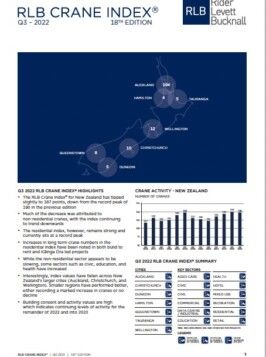Following the Omicron outbreak and peak earlier in 2022, construction has continued at pace, even in the face of some productivity impacts with on-site labour resource constraints and continued supply chain disruptions.
The residential sector continues to power the NZ construction industry with a record 77 cranes in this edition, up five from the previous edition. This includes a record 59 residential cranes in Auckland with a further seven aged care cranes in Auckland in this new category.
According to today’s release of the Q3 2022 RLB Crane Index®, New Zealand has 148 long-term cranes on construction sites across the seven main centres. 104 cranes in Auckland, 12 in Wellington, 10 in Christchurch, 8 in Queenstown, 5 in Tauranga, 5 in Dunedin and 4 in Hamilton.
Construction activity proves highly resilient
Rider Levett Bucknall Chris Haines said, “The resilience in construction throughout 2021 and 2022 remains strong with significant activity across most sectors.”
He added, “New Zealand’s construction activity has continued to prove to be highly resilient, as the value of work put in place over the year to June 2022 stands at $30.9 billion, up 12.4% over 2021.”
“The strength of the residential sector has continued into the year to June 2022, with a 14.5% lift in activity, while the non-residential sector increased by 8.1%.”
Chris continued, “Our housing market may have pulled back throughout 2022 in both sales volumes and prices following the record increases seen in 2021, but the record residential crane numbers in the current count are for long-term cranes on projects that have been planned and funded in 2021. Looking forward, whilst the Aged Care, Build to Rent and Kãinga Ora pipeline is strong, the residential development pipeline is weaker into 2023 and we are potentially seeing a lag in the change to crane numbers on residential construction sites”
Building consents up despite economic environment
Overall, the pipeline of construction work to start has remained remarkably resilient, despite the current economic environment. Building consents for the 12 months to June 2022 has totalled $31.5 billion, up 18.5% over the $26.5 billion figure recorded in the year to June 2021.
According to the RLB Crane Index, whilst crane numbers are down slightly for the three largest regions of Auckland, Christchurch and Wellington, smaller regions have either seen a net increase in crane activity, or at least have remained the same, with a significant movement seen in Dunedin (from one to five cranes).
Cost escalation and labour resources still biggest issues
Chris continued, “While long term cranes numbers in Auckland fell from 108 to 104, current figures are still the second highest on record in the biggest construction market in the country. Continued cost escalation and labour resources are the two biggest issues facing the industry and it will be interesting to see how the Residential sector performs in 2023 and whether pull back in demand and new projects can help the Non-Residential Sectors in terms of labour, pricing and affordability into next year.”
He added, “The number of residential long-term cranes increased to a new record high of 59 cranes, 10 cranes were removed from developments which were offset by an additional 13 new long-term cranes. In contrast, non-residential cranes decreased by a net total of 7.”
Auckland cranes shifting to suburbs
In Auckland, the shift in cranes outwards has continued, with most new residential cranes being located in the suburbs. Residential cranes now account for 57% of all long-term cranes across the city. This includes new cranes on private residential developments, Build to Rent and Kãinga Ora sites. Auckland has a further 6 cranes in the Aged Care sector, now reported separately.
Despite the minor overall decrease in long-term crane numbers, the level of building work put in place for the twelve months to June 2022 has in-fact increased by 11.0%, to an annual result of $12.2b. The level of residential building work has contributed significantly to the increase in building work put in place, while non-residential activity grew by a comparatively minor proportion.
Decrease in non-residential cranes due to civil sector
With residential cranes across NZ up by a net value of five, 77 long-term cranes are currently up and active, representing just over half of all cranes counted.
The decrease in the non-residential cranes is mostly attributed to the civil sector, and roading and bridge projects, seeing a net decrease of six cranes, while the data centre and recreational sectors both saw a decrease of three cranes each.
However, offsetting these falls was a pickup in the health sector where the number of cranes increased from two to six. Aged care cranes remained steady at seven.
FURTHER INFORMATION:



